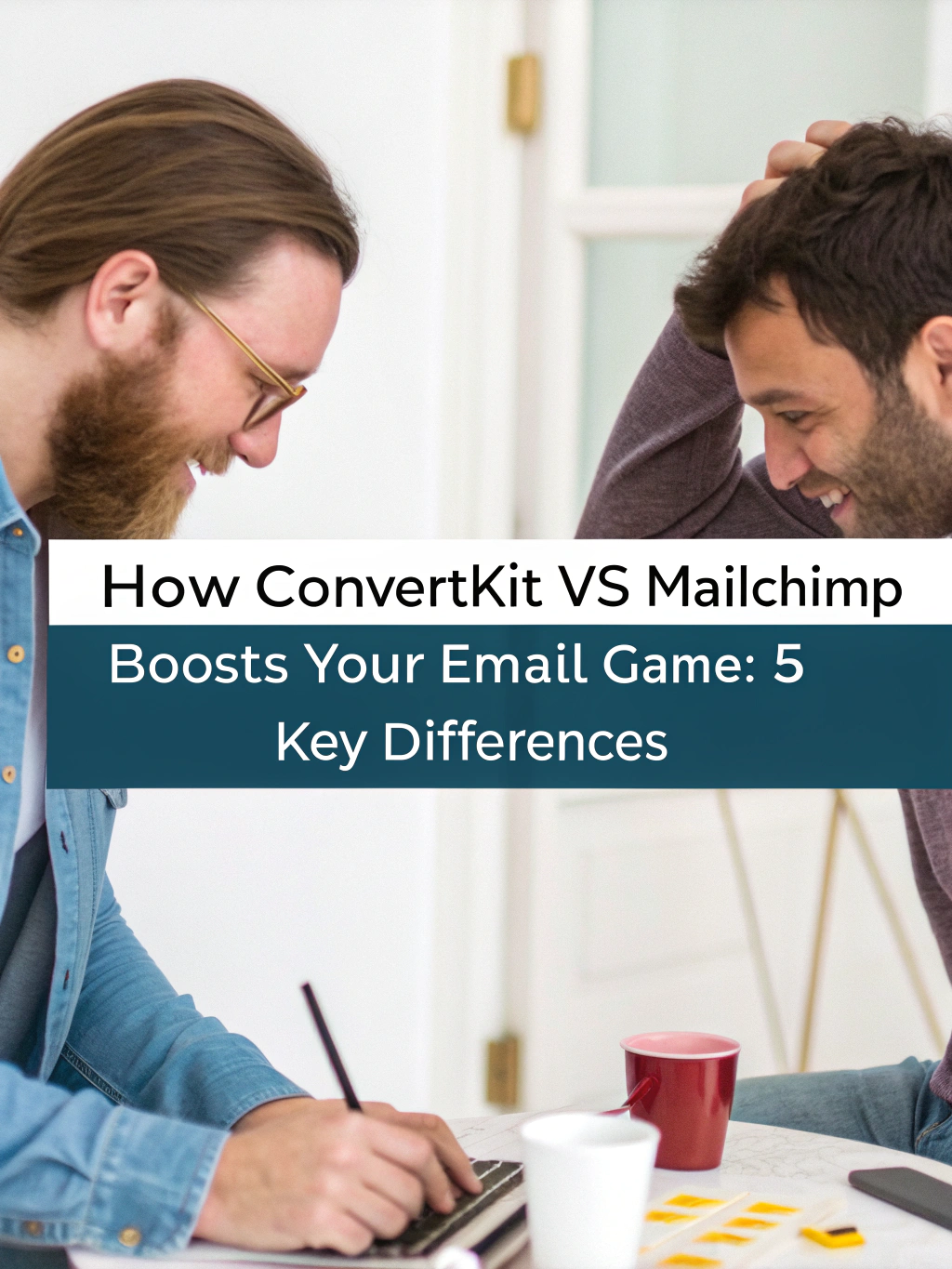Are you staring at your email marketing metrics and wondering why your open rates remain stubbornly low? You’re not alone. I remember spending countless hours crafting what I thought were perfect email campaigns, only to see disappointing results month after month. The turning point came when I realized I wasn’t using the right tool for my specific needs. Struggling with email marketing? Explore the convertkit vs mailchimp showdown to enhance your strategy with five vital distinctions. Discover which tool fits your needs best!
Email marketing remains one of the most effective ways to connect with your audience, but choosing between industry titans like ConvertKit and Mailchimp can be overwhelming. Both platforms promise to elevate your email strategy, but they do so in fundamentally different ways. Let’s cut through the confusion and explore the five key differences that could transform your email marketing results.
The Fundamental Philosophy: Audience vs. List Management
ConvertKit and Mailchimp approach email marketing from distinctly different perspectives, and understanding this core difference is crucial to making the right choice for your business.
ConvertKit’s Subscriber-Centric Approach
ConvertKit was built with creators in mind. Its philosophy centers around treating subscribers as individual people rather than data points on various lists. This means:
- Each subscriber exists as a single entity in your account
- Tags and segments are used to categorize subscribers instead of multiple lists
- You pay only once for each subscriber, regardless of how many segments they belong to
Mailchimp’s List-Based Structure
Mailchimp, a pioneer in the email marketing space, operates on a traditional list-based model:
- Subscribers are organized into separate lists
- The same person on multiple lists counts as multiple subscribers
- Advanced segmentation is available but built on top of the list structure
This fundamental difference impacts everything from pricing to how you’ll structure your email marketing strategy. For content creators who frequently segment their audience, ConvertKit vs Mailchimp comparison often favors ConvertKit’s approach.
Automation Capabilities: Simple vs. Comprehensive

The power of automation can make or break your email marketing strategy. Let’s see how these platforms stack up.
ConvertKit’s Visual Automation Builder
ConvertKit excels with its intuitive visual automation builder that allows you to:
- Create sophisticated email sequences with a drag-and-drop interface
- Set up trigger-based workflows that respond to subscriber actions
- Implement tag-based automations that dynamically segment your audience
Mailchimp’s Marketing Automation Tools
Mailchimp offers robust automation features with:
- Pre-built automation templates for common scenarios
- Customer journey mapping capabilities
- Behavioral targeting options
- Integration with e-commerce platforms for purchase-triggered emails
The key difference lies in accessibility and learning curve. ConvertKit offers a more straightforward approach that many creators find easier to master, while Mailchimp provides more extensive options but with a steeper learning curve. For those seeking to improve your email marketing with minimal technical headaches, ConvertKit often wins this category.
Design Flexibility: Minimalist vs. Creative Freedom
Your email design impacts brand perception and engagement rates. Here’s how the platforms compare:
ConvertKit’s Minimalist Templates
ConvertKit deliberately keeps its templates simple and text-focused:
- Clean, distraction-free designs
- Limited creative customization options
- Mobile-responsive layouts that prioritize readability
- Focus on content rather than design elements
Mailchimp’s Extensive Design Options
Mailchimp gives you considerable creative control:
- Dozens of professionally designed templates
- Advanced drag-and-drop editor
- Extensive customization capabilities
- Built-in photo editing tools
For email marketing strategy enhancement, the right choice depends on your priorities. If you believe in the power of plain text and simple designs to boost engagement, ConvertKit aligns with this philosophy. If rich, visually engaging emails are central to your strategy, Mailchimp provides more tools to realize your creative vision.
Pricing Structure: Creator-Friendly vs. Tiered Approach
The cost of your email marketing solution directly impacts your ROI. Here’s a comparison of pricing structures:
ConvertKit’s Subscriber-Based Pricing
| Subscriber Count | Monthly Fee (Free Plan) | Monthly Fee (Creator Plan) | Monthly Fee (Creator Pro) |
|---|---|---|---|
| 0-300 | $0 | $9 | $25 |
| 301-1,000 | Not Available | $25 | $41 |
| 1,001-3,000 | Not Available | $41 | $66 |
| 3,001-5,000 | Not Available | $66 | $83 |
Mailchimp’s Tiered Pricing Model
| Subscriber Count | Monthly Fee (Free) | Monthly Fee (Essentials) | Monthly Fee (Standard) | Monthly Fee (Premium) |
|---|---|---|---|---|
| 0-500 | $0 | $11 | $17 | Not Available |
| 501-2,500 | Not Available | $20 | $32 | $78 |
| 2,501-5,000 | Not Available | $50 | $80 | $175 |
| 5,001-10,000 | Not Available | $85 | $125 | $250 |
When choosing between ConvertKit and Mailchimp, consider your growth trajectory. ConvertKit often proves more economical for creators with subscribers spread across multiple interests, while Mailchimp’s free tier might be attractive for businesses just starting out.
Integration Ecosystem: Focused vs. Expansive
The ability to connect your email platform with other tools in your tech stack is crucial for a seamless workflow.
ConvertKit’s Creator-Focused Integrations
ConvertKit offers:
- Direct integrations with popular creator tools (WordPress, Teachable, Shopify)
- Zapier connection for extended functionality
- Focus on platforms commonly used by content creators and digital product sellers
Mailchimp’s Vast Integration Network
Mailchimp boasts:
- 250+ direct integrations with business tools across categories
- Advanced e-commerce integrations
- CRM connections
- Social media platform integrations
For best tools for email marketing, your existing tech stack should influence your decision. Creators with focused needs often find ConvertKit’s integrations sufficient, while businesses using diverse software tools may benefit from Mailchimp’s broader ecosystem.
Making Your Final Decision: Which Platform Wins?
The ultimate winner in the email marketing software showdown depends entirely on your specific needs:
Choose ConvertKit if you:
- Are a content creator, author, blogger, or course creator
- Value simple, content-focused email design
- Need intuitive audience segmentation
- Prefer straightforward automation tools
- Want subscriber-based rather than list-based management
Choose Mailchimp if you:
- Run an e-commerce store with complex needs
- Require advanced design capabilities
- Need sophisticated marketing analytics
- Value having a free tier for small subscriber counts
- Utilize a diverse technology stack requiring extensive integrations
Both platforms offer impressive capabilities, but they serve different types of businesses best. By focusing on the five key differences we’ve explored, you can make a choice that aligns with your specific email marketing goals and business model.
FAQ: ConvertKit vs Mailchimp
Which is better for beginners, ConvertKit or Mailchimp?
While Mailchimp offers a free plan for up to 500 subscribers that many beginners find attractive, ConvertKit’s interface is often considered more intuitive. For complete beginners focused on creating content rather than complex marketing campaigns, ConvertKit’s streamlined approach may be easier to master despite the higher starting cost.
Can I easily migrate from Mailchimp to ConvertKit or vice versa?
Yes, both platforms offer migration tools and assistance. ConvertKit specifically provides a concierge migration service for certain plan levels to help transfer your convertkit vs mailchimp subscribers and campaigns smoothly.
Which platform offers better deliverability rates?
Both platforms maintain good deliverability rates, but ConvertKit often edges out slightly in this category due to its focus on engaged subscribers and simpler email designs that are less likely to trigger spam filters.
Is ConvertKit or Mailchimp better for e-commerce businesses?
Mailchimp typically offers more robust e-commerce features, including advanced product recommendations, abandoned cart emails, and shoppable landing pages. However, ConvertKit has been improving its e-commerce capabilities and works well for creators selling digital products.
Do ConvertKit and Mailchimp offer landing page builders?
Yes, both platforms include landing page builders. Mailchimp offers more design variety, while ConvertKit’s landing pages are simpler but often convert well due to their focused, distraction-free approach.
By understanding these essential differences in email marketing tools, you can make a strategic choice that elevates your email marketing results and helps you build more meaningful connections with your audience.






